Search Result
Results for "
Ca2 influx
" in MedChemExpress (MCE) Product Catalog:
2
Biochemical Assay Reagents
2
Isotope-Labeled Compounds
| Cat. No. |
Product Name |
Target |
Research Areas |
Chemical Structure |
-
- HY-N3729
-
|
Denudatin B
|
Calcium Channel
|
Cardiovascular Disease
|
|
(-)-Denudatin B is an antiplatelet agent. (-)-Denudatin B relaxed vascular smooth muscle by inhibiting the Ca2+ influx through voltage-gated and receptor-operated Ca2+ channels . And (-)-Denudatin B has nonspecific antiplatelet action
|
-
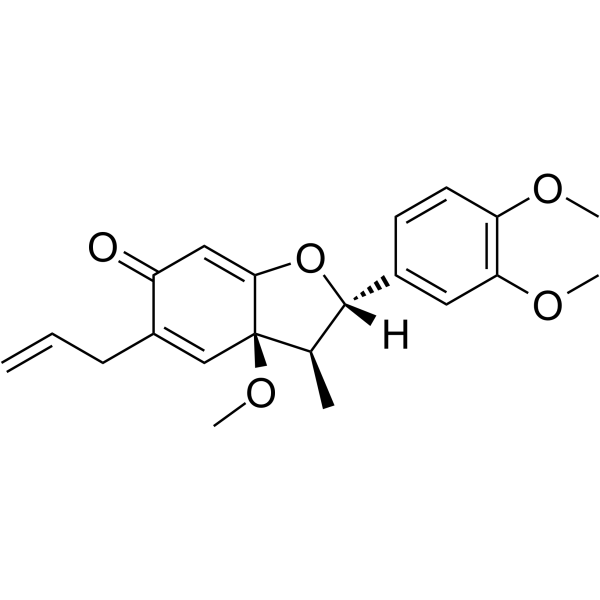
-
- HY-14656S
-
|
|
Calcium Channel
|
Cardiovascular Disease
|
|
Diltiazem-d3 (hydrochloride) is the deuterium labeled Diltiazem hydrochloride. Diltiazem hydrochloride is a Ca2+ influx inhibitor (slow channel blocker or calcium antagonist)[1][2].
|
-
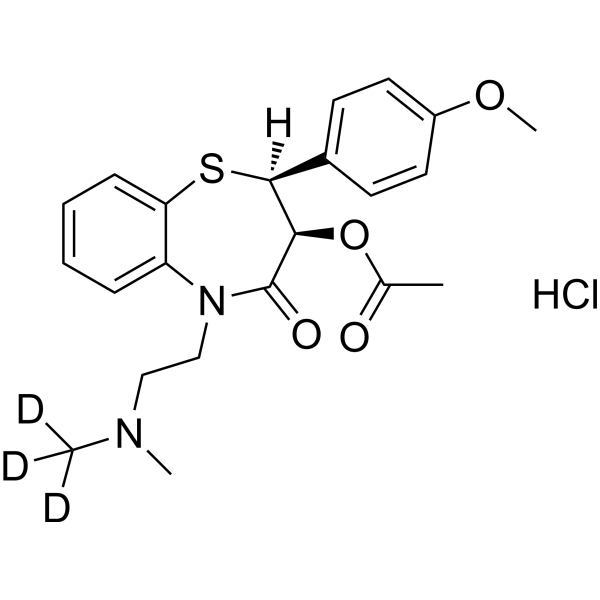
-
- HY-12504
-
Pyr6
1 Publications Verification
N-[4-[3,5-Bis(trifluoromethyl)-1H-pyrazol-1-yl]phenyl]-3-fluoro-4-pyridineCarboxamide
|
TRP Channel
|
Others
|
|
Pyr6 is a selective inhibitor of TRPC3 with IC50 of 0.49 uM(Ca2+ influx inhibition in thapsigargin depleted native RBL-2H3 cells).
|
-
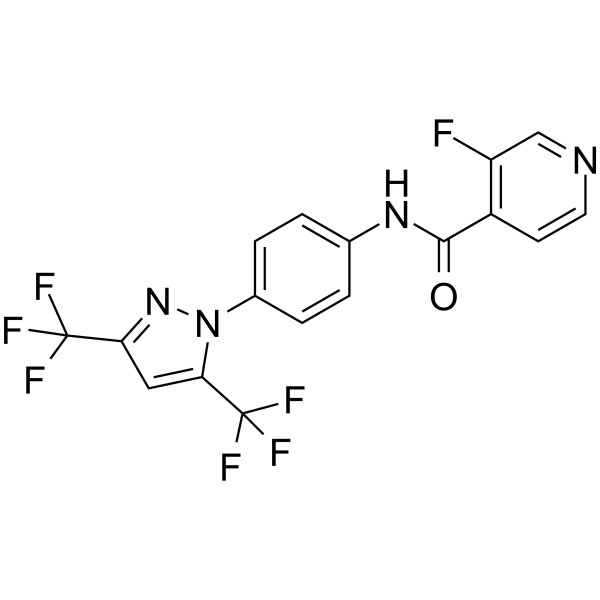
-
- HY-12962
-
|
|
iGluR
|
Neurological Disease
|
|
NMDA-IN-1 is a potent and NR2B-selective NMDA antagonist with Ki of 0.85 nM; NR2B Ca2+ influx IC50 is 9.7 nM; no activities on NR2A, NR2C, NR2D, hERG-channel and α1-adrenergic receptor.
|
-
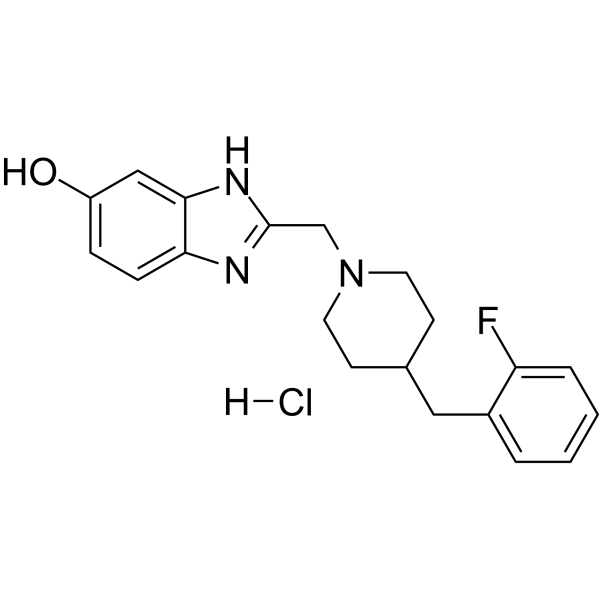
-
- HY-14656S1
-
-
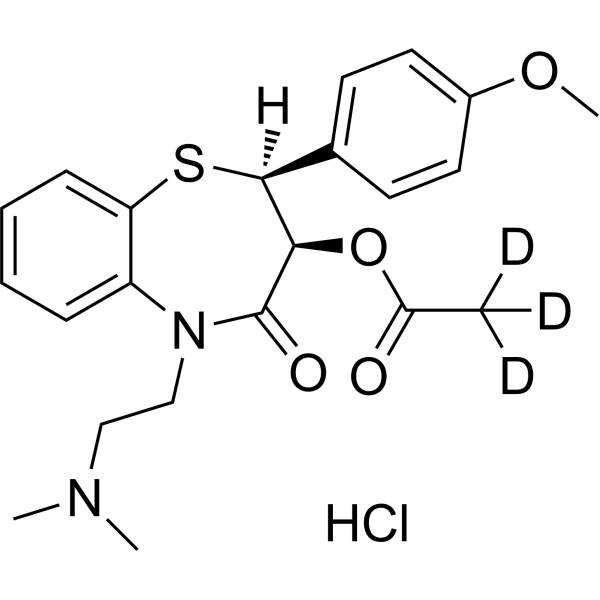
-
- HY-14656
-
-
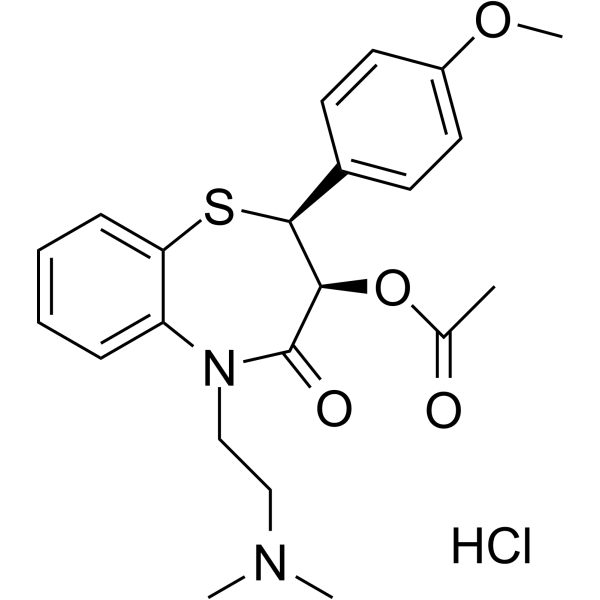
-
- HY-19608
-
-
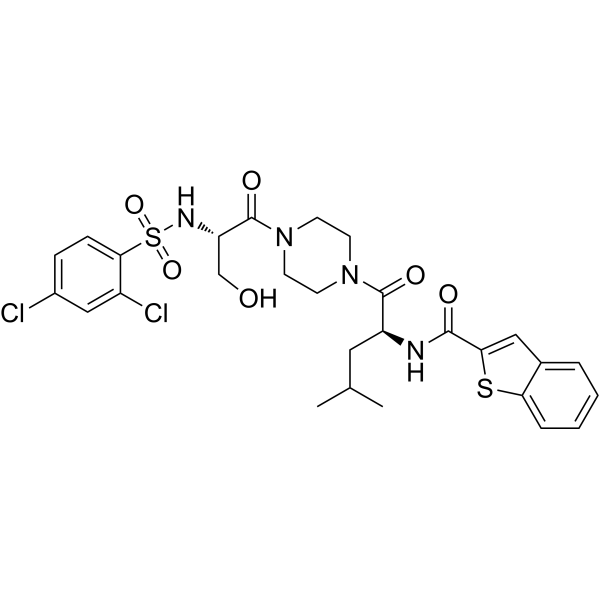
-
- HY-P3037
-
|
|
Calcium Channel
|
|
|
Imperatoxin A, a peptide toxin derived from the venom of the African scorpion Pandinus imperator, activator of Ca 2+-release channels/ryanodine receptors (RyRs)? enhances the influx of Ca 2+ from the sarcoplasmatic reticulum into the cell .
|
-

-
- HY-129088
-
-
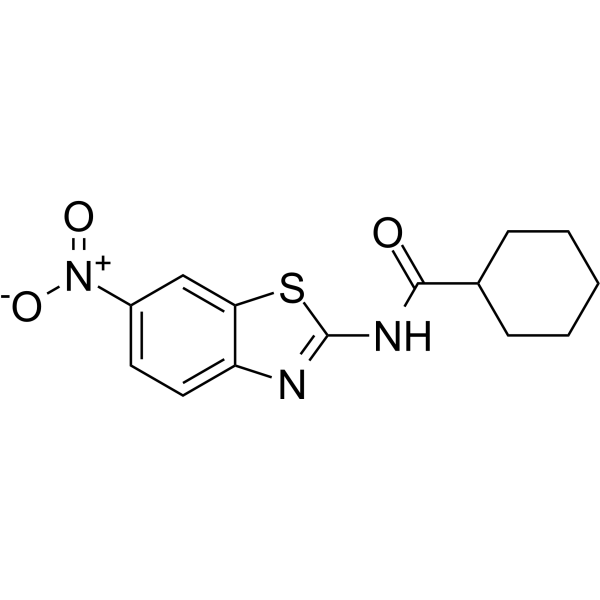
-
- HY-A0057
-
|
|
Calcium Channel
|
Neurological Disease
Cancer
|
|
Gabapentin is a potent, orally active P/Q type Ca 2+ channel blocker. Gabapentin inhibits neuronal Ca 2+ influx and reduction of neurotransmitter release. Gabapentin is a GABA analog that can be used to relieve neuropathic pain .
|
-

-
- HY-A0057A
-
|
|
Calcium Channel
|
Neurological Disease
Cancer
|
|
Gabapentin hydrochloride is a potent, orally active P/Q type Ca 2+ channel blocker. Gabapentin hydrochloride inhibits neuronal Ca 2+ influx and reduction of neurotransmitter release. Gabapentin hydrochloride is a GABA analog that can be used to relieve neuropathic pain .
|
-

-
- HY-14656R
-
|
CRD-401 (Standard)
|
Calcium Channel
|
Cardiovascular Disease
Cancer
|
|
Diltiazem (hydrochloride) (Standard) is the analytical standard of Diltiazem (hydrochloride). This product is intended for research and analytical applications. Diltiazem hydrochloride is a Ca 2+ influx inhibitor (slow channel blocker or calcium antagonist).
|
-

-
- HY-N0081A
-
|
|
Calcium Channel
|
Cardiovascular Disease
|
|
(-)-Praeruptorin A is a nature product that could be isolated from the roots of Peucedanum praeruptorum Dunn. (-)-Praeruptorin A relaxes ileum and tracheal smooth muscles by activating NO/cGMP signaling pathway. (-)-Praeruptorin A has dramatically therapeutic effects on hypertension mainly through acting as a Ca 2+-influx blocker .
|
-

-
- HY-N2060
-
-
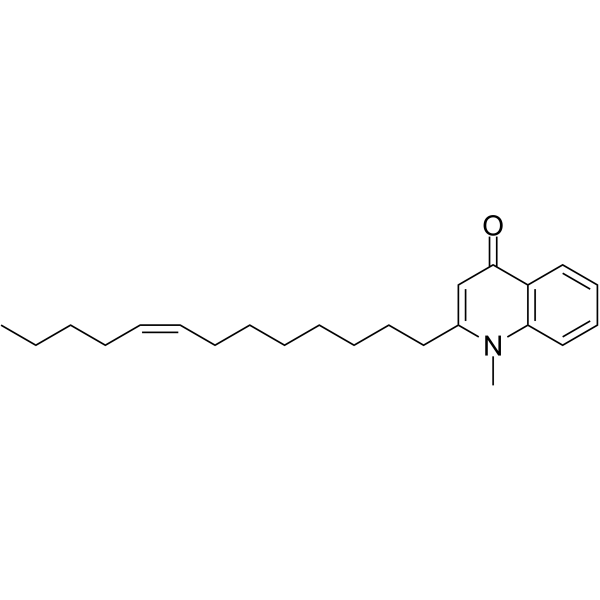
-
- HY-108465
-
|
|
TRP Channel
|
Others
|
|
Pyr3 is a selective inhibitor of transient receptor potential canonical channel 3 (TRPC3), with an IC50 of 700 nM for TRPC3-mediated Ca 2+ influx.
|
-
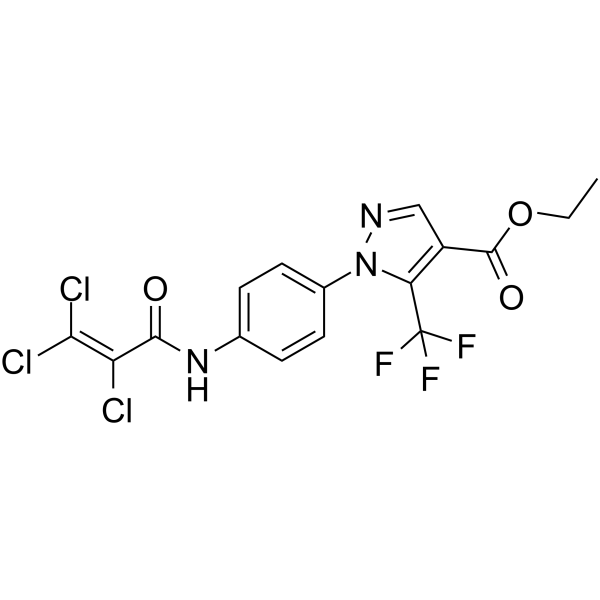
-
- HY-120691A
-
-
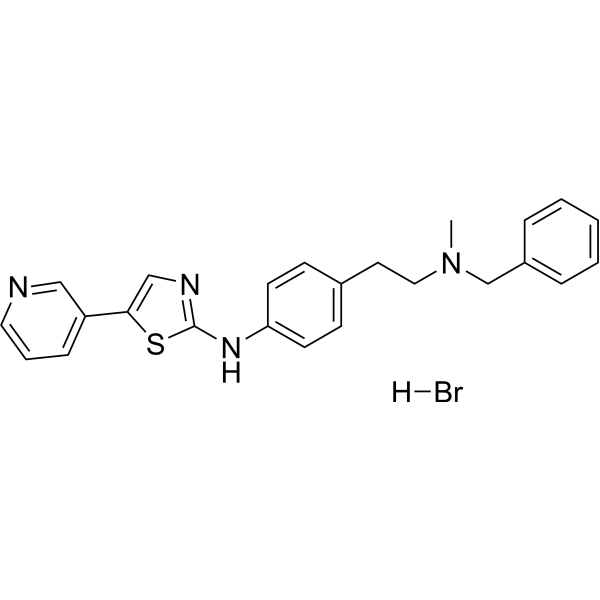
-
- HY-115767
-
|
1,2-Dioleoyl-rac-glycerol
|
PKC
|
Others
|
|
(±)-1,2-Diolein (1,2-Dioleoyl-rac-glycerol) is a PKC activator. (±)-1,2-Diolein increases myotubes Ca 2+ influx .
|
-
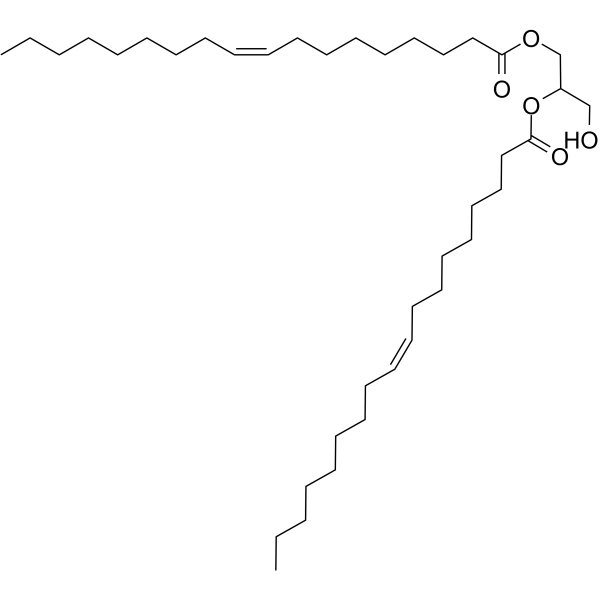
-
- HY-133168
-
|
|
TRP Channel
|
Cancer
|
|
Englerin A is a potent and selective activator of TRPC4 and TRPC5 channels, with EC50s of 11.2 and 7.6 nM, respectively. Englerin A can induce renal carcinoma cells death by elevated Ca 2+ influx and Ca 2+ cell overload .
|
-

-
- HY-117073
-
|
|
Calcium Channel
|
Neurological Disease
|
|
ITH12575, a CGP37157 derivative, is a potent and selective mNCX blocker. ITH12575 reduces Ca 2+ influx through CALHM1 at low micromolar concentrations .
|
-

-
- HY-100168
-
|
|
Phospholipase
|
Others
|
|
BAPTA is a selective chelator for calcium. BAPTA, as calcium indicator, has high selectivity against magnesium and calcium. BAPTA is widely used as an intracellular buffer for investigating the effects of Ca 2+ release from intracellular stores or influx via Ca 2+-permeable channels in the plasma membrane. BAPTA can also inhibit phospholipase C activity independently of their role as Ca 2+ chelators .
|
-

-
- HY-101017
-
|
|
Endogenous Metabolite
|
Inflammation/Immunology
Cancer
|
|
Palmitoylcarnitine chloride is a fatty acid-derived mitochondrial substrate, and selectively decreases cell survival in colorectal and prostate cancer cells by affecting on pro-inflammatory pathways, Ca 2+ influx, and DHT-like effects .
|
-
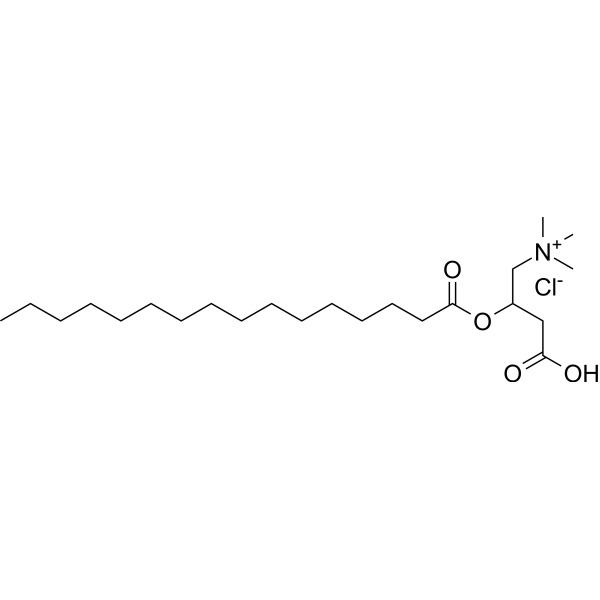
-
- HY-135897
-
-

-
- HY-101015A
-
-
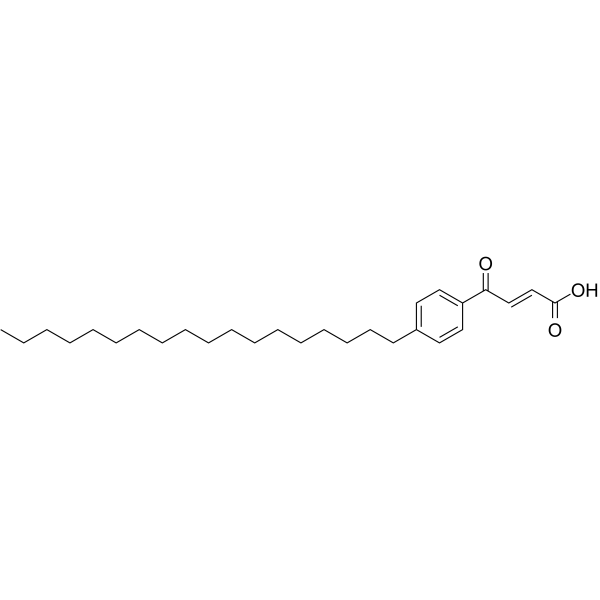
-
- HY-100168B
-
|
|
Phospholipase
|
Others
|
|
BAPTA tetrapotassium is a selective chelator for calcium. BAPTA, as calcium indicator, has high selectivity against magnesium and calcium. BAPTA tetrapotassium is widely used as an intracellular buffer for investigating the effects of Ca 2+ release from intracellular stores or influx via Ca 2+-permeable channels in the plasma membrane. BAPTA tetrapotassium can also inhibit phospholipase C activity independently of their role as Ca 2+ chelators .
|
-
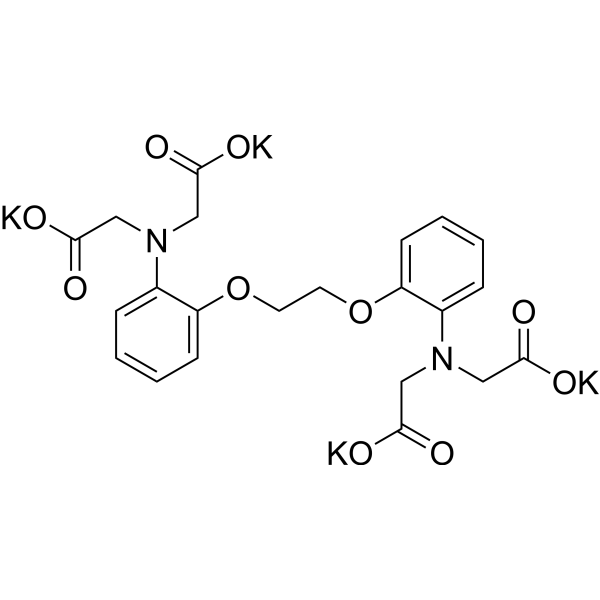
-
- HY-N7875
-
|
|
Others
|
Others
|
|
Celangulin is an insecticidal component isolated from Celastrus angulatus. Celangulin activates the calcium channel on the plasma membrane with increasing the intracellular Ca 2+ after influx from the external. Celangulin activates the calcium channel in the ER .
|
-

-
- HY-P5796
-
|
|
Calcium Channel
|
Neurological Disease
|
|
FS-2 is a potent and specific L-type CaV channel inhibitor. FS-2 inhibits high K + or glucose induced L-type Ca 2+ influx in RIN beta cells .
|
-

-
- HY-100168A
-
|
|
Phospholipase
|
Others
|
|
BAPTA tetrasodium is a selective chelator for calcium. BAPTA tetrasodium, as calcium indicator, has high selectivity against magnesium and calcium. BAPTA tetrasodium is widely used as an intracellular buffer for investigating the effects of Ca 2+ release from intracellular stores or influx via Ca 2+-permeable channels in the plasma membrane. BAPTA tetrasodium can also inhibit phospholipase C activity independently of their role as Ca 2+ chelators .
|
-

-
- HY-116291
-
-

-
- HY-10588
-
|
(±)-Bay K 8644
|
Calcium Channel
|
Cardiovascular Disease
Neurological Disease
|
|
Bay K 8644 ((±)-Bay K 8644) is a racemate consisting of two isomers (R)-(+)-Bay-K-8644 and (S)-(-)-Bay-K-8644 . Bay K 8644 is a L-type Ca 2+ channel agonist with an EC50 of 17.3 nM. Bay K 8644 increases Ca 2+ influx through sarcolemmal Ca 2+ channels by increasing the open time of the channel. Bay K 8644 has vasoconstrictive effects .
|
-

-
- HY-12323
-
|
Isoxazole 9
|
Calcium Channel
|
Neurological Disease
|
|
ISX-9 (Isoxazole 9) is a potent inducer of adult neural stem cell differentiation. ISX-9 activates Ca 2+ influx through both voltage-gated Ca 2+ channels and NMDA receptors and increases neuroD expression. ISX-9 also induces cardiomyogenic differentiation of Notch-activated epicardium-derived cells (NECs) .
|
-
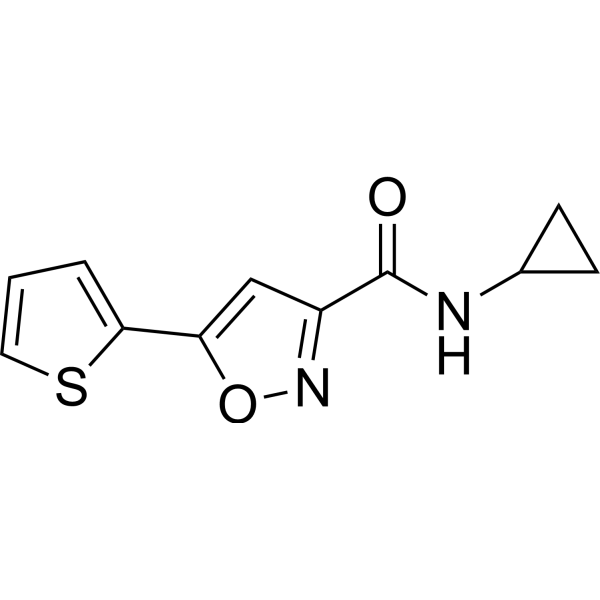
-
- HY-P3156
-
|
|
Fungal
|
Infection
|
|
Syringomycin E is an antifungal cyclic lipodepsinonapeptide. Syringomycin E exhibits growth inhibition of Saccharomyces cerevisiae through interaction with the plasma membrane. Syringomycin E causes K + efflux, Ca 2+ influx, and changes in membrane potential, and is related to channel formation .
|
-
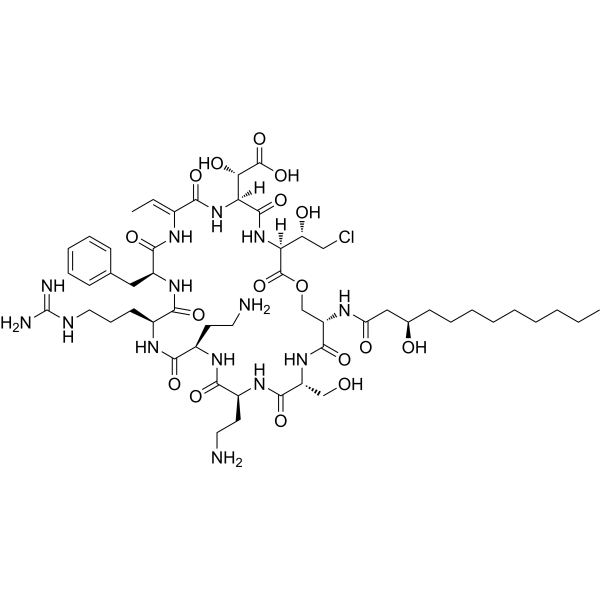
-
- HY-N2344
-
|
Proanthocyanidin A1
|
PKC
|
Inflammation/Immunology
|
|
Procyanidin A1 (Proanthocyanidin A1) is a procyanidin dimer, which inhibits degranulation downstream of protein kinase C activation or Ca 2+ influx from an internal store in RBL-213 cells. Procyanidin A1 has antiallergic effects .
|
-
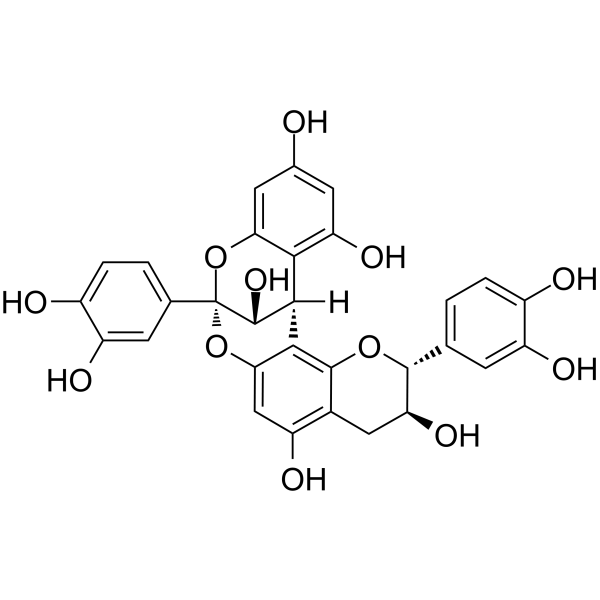
-
- HY-N0081
-
|
|
Calcium Channel
|
Infection
|
|
(±)-Praeruptorin A is the di-esterified product of cis-khellactone (CKL) and the major active ingredient in Peucedani Radix which consists of the dried roots of Peucedanum praeruptorumDunn (Apiaceae). (±)-Praeruptorin A has been widely employed as one of the famous traditional Chinese medicines (TCMs) for the treatment of cough with thick sputum and dyspnea, nonproductive cough and upper respiratory infections for centuries in China. (±)-Praeruptorin A has dramatically therapeutic effects on hypertension mainly through acting as a Ca 2+-influx blocker .
|
-
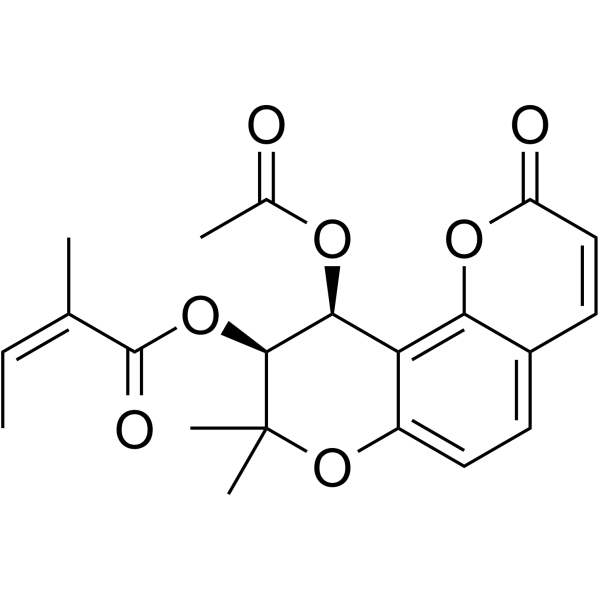
-
- HY-106837
-
|
Y 24180
|
Platelet-activating Factor Receptor (PAFR)
|
Inflammation/Immunology
|
|
Israpafant (Y-24180) is a potent, selective and long-acting platelet activation factor (PAF) receptor antagonist with IC50s of 0.84 nM and 3.84 nM against PAF-induced human and rabbit platelet aggregation, respectively. Israpafant stimulates both extracellular Ca 2+ influx and intracellular Ca 2+ release in prostate cancer cells. Israpafant suppresses the allergic cutaneous reactions including eosinophilia, cytokine production, edema and erythema in mice .
|
-

-
- HY-130358
-
|
|
Calcium Channel
|
Neurological Disease
|
|
PDDHV is a calcium absorption inducer and may achieve 45Ca 2+ influx by stimulating vanillic acid receptor VR1. PDDHV induces 45Ca 2+ uptake (EC50: 70 nM) in rat dorsal root ganglion neurons (expressing native vanilloid receptors) and calcium mobilization (EC50: 125 nM) in VR1-transfected CHO cells. PDDHV also inhibits [3H]-resiniferatoxin (RTX) binding to the dorsal root ganglion membrane in rats .
|
-

-
- HY-N4267
-
|
|
Calcium Channel
|
Infection
Cardiovascular Disease
|
|
Yangambin, a furofuran lignan, is already isolated from plants such as member of the Annonaceae family, including species of the genus Rollinia: R. pickeli, R. exalbidaand R. mucosa, as well from the Magnolia biondii. Yangambin, a selective PAF receptor antagonist, inhibits Ca 2+ influx through voltage-gated Ca 2+ channels, leading to the reduction in [Ca 2+]i in vascular smooth muscle cells and consequent peripheral vasodilation . Yangambin exhibits the antiallergic activity against β-hexosaminidase release with an IC50 of 33.8 μM and for anti-inflammatory activity with an IC50 of 37.4 μM .
|
-

-
- HY-16935
-
|
JNJ-39439335
|
TRP Channel
|
Neurological Disease
|
|
Mavatrep (JNJ-39439335) is an orally active, selective and potent TRPV1 antagonist with high affinity for hTRPV1 channels (Ki=6.5 nM). Mavatrep antagonizes capsaicin-induced Ca 2+ influx with an IC50 value of 4.6 nM. Mavatrep can be used in some studies of neuropathic pain .
|
-
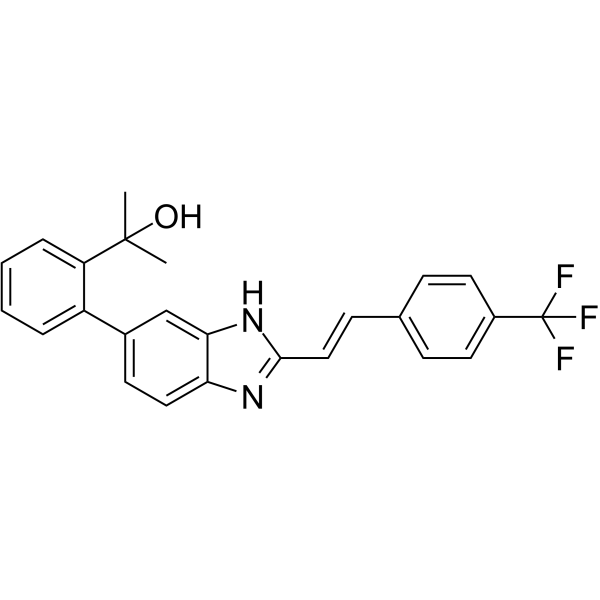
-
- HY-107411
-
|
(6E)-Bromoenol lactone
|
Phospholipase
|
Inflammation/Immunology
|
|
Bromoenol lactone ((6E)-Bromoenol lactone) is a suicide-based irreversible, selective, potent inhibitor of calcium-independent phospholipase A2 (iPLA2β) with an IC50 value of approximately 7 μM, which inhibits antigen-stimulated mast cell exocytosis without blocking Ca 2+ influx .
|
-
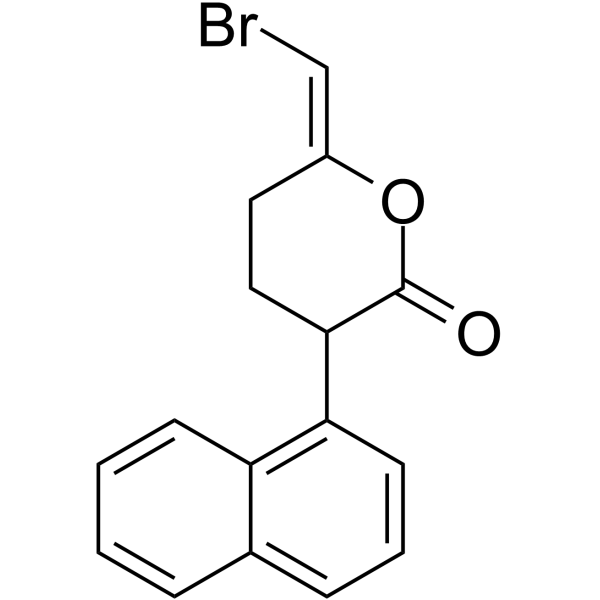
-
- HY-101015
-
|
|
Phospholipase
Apoptosis
|
Inflammation/Immunology
|
|
(2E)-OBAA is a potent phospholipase A2 (PLA2) inhibitor, with an IC50 of 70 nM. (2E)-OBAA induces apoptosis of HUVEC cells. (2E)-OBAA blocks Melittin-induced Ca 2+ influx in Trypanosoma brucei, with an IC50 of 0.4 μM .
|
-
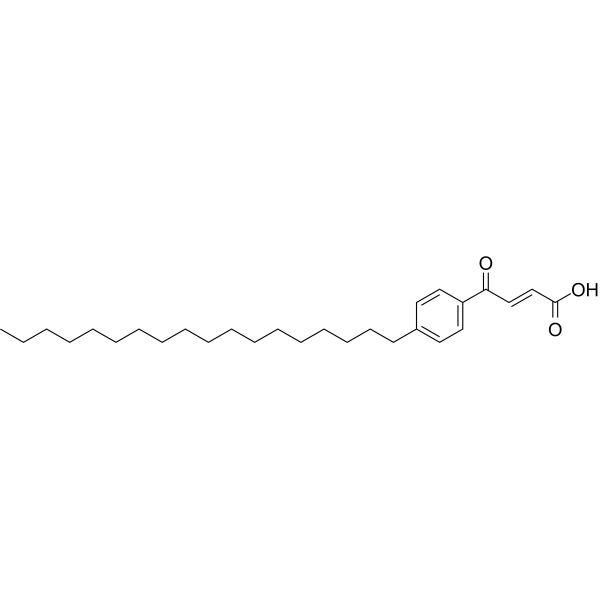
-
- HY-103442
-
|
DAPH
|
EGFR
Amyloid-β
|
Neurological Disease
Cancer
|
|
CGP52411 (DAPH) is a high selective, potent, orally active and ATP-competitive EGFR inhibitor with an IC50 of 0.3 μM. CGP52411 blocks the toxic influx of Ca 2+ ions into neuronal cells, and dramatic inhibits and reverses the formation of β-amyloid (Aβ42) fibril aggregates associated with Alzheimer's disease .
|
-

-
- HY-115864
-
|
TAK-653
|
iGluR
Lipoxygenase
|
Neurological Disease
|
|
Osavampator (TAK-653) is a AMPA receptor positive allosteric modulator. Osavampator selectively binds to AMPA-R in a glutamate-dependent manner and induces Ca 2+ influx in hGluA1i CHO cells (EC50 = 3.3 μM). Osavampator improves learning and memory in many models. Osavampator is can be used for the research of depressive disorders .
|
-
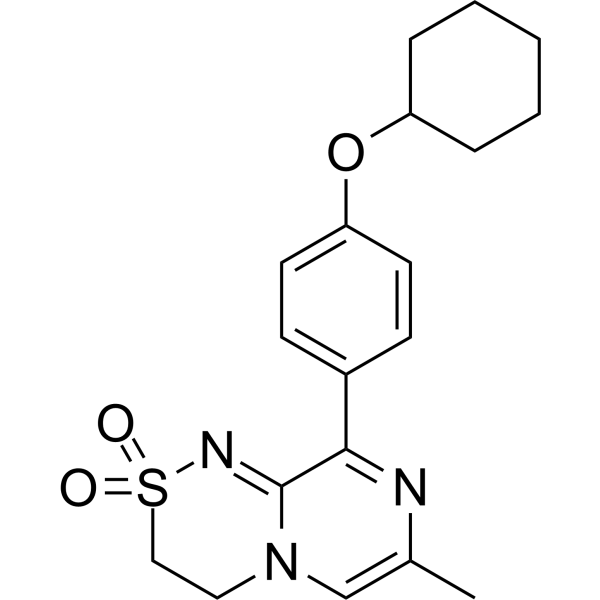
-
- HY-P1080
-
|
|
Calcium Channel
|
Neurological Disease
|
|
ω-Agatoxin IVA is a potent, selective P/Q type Ca 2+ (Cav2.1) channel blocker with IC50s of 2 nM and 90 nM for P-type and Q-type Ca 2+ channels, respectively. ω-Agatoxin IVA (IC50, 30-225 nM) inhibits glutamate exocytosis and calcium influx elicited by high potassium. ω-Agatoxin IVA also blocks the high potassium-induced release of serotonin and norepinephrine. ω-Agatoxin IVA has no effect on L-type or N-type calcium channels .
|
-

-
- HY-18723
-
Yoda 1
Maximum Cited Publications
27 Publications Verification
|
Piezo Channel
Akt
ERK
Potassium Channel
|
Cardiovascular Disease
|
|
Yoda 1 is a potent and selective Piezo1 agonist. Yoda 1 activates purified Piezo1 channels. Yoda 1 potently inhibits macropinocytosis induced by epidermal growth factor (EGF). Yoda 1 enhances Ca 2+ influx followed by activation of the calcium-activated potassium channel KCa3.1 and inhibition of Rac1 activation .
|
-
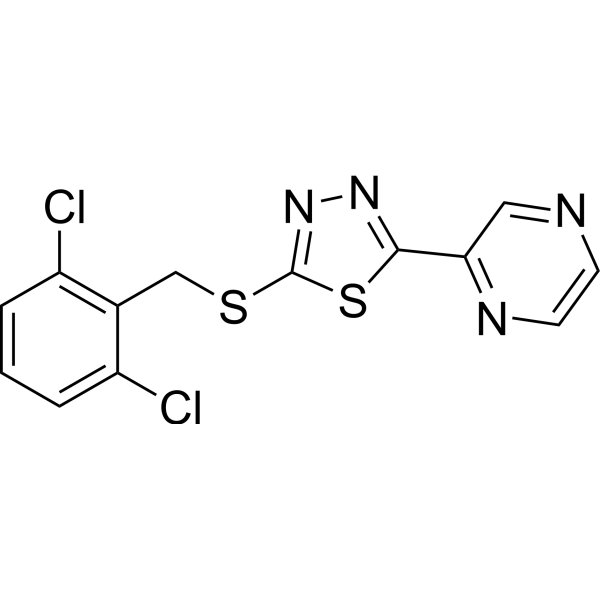
-
- HY-19408
-
Pyr10
3 Publications Verification
|
TRP Channel
|
Others
|
|
Pyr10 is a pyrazole derivative and a selective TRP cation 3 (TRPC3) inhibitor. Pyr10 inhibits Ca 2+ influx in carbachol-stimulated TRPC3-transfected HEK293 cells with an IC50 of 0.72 μM (IC50 of 13.08 μM for store operated Ca 2+ entry in BRL-2H3 cells). Pyr10 has the ability to distinguish between receptor-operated TRPC3 and native stromal interaction molecule 1 (STIM1)/Orai1 channels .
|
-
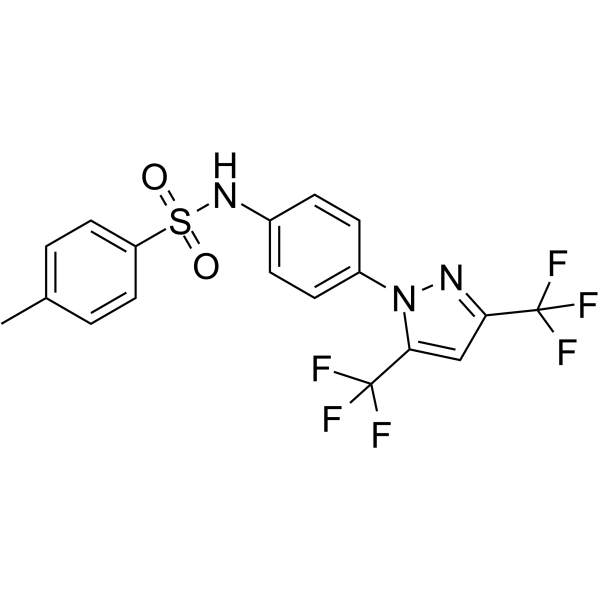
-
- HY-P1080A
-
|
|
Calcium Channel
|
Neurological Disease
|
|
ω-Agatoxin IVA TFA is a potent, selective P/Q type Ca 2+ (Cav2.1) channel blocker with IC50s of 2 nM and 90 nM for P-type and Q-type Ca 2+ channels, respectively. ω-Agatoxin IVA TFA (IC50, 30-225 nM) inhibits glutamate exocytosis and calcium influx elicited by high potassium. ω-Agatoxin IVA TFA also blocks the high potassium-induced release of serotonin and norepinephrine. ω-Agatoxin IVA TFA has no effect on L-type or N-type calcium channels .
|
-
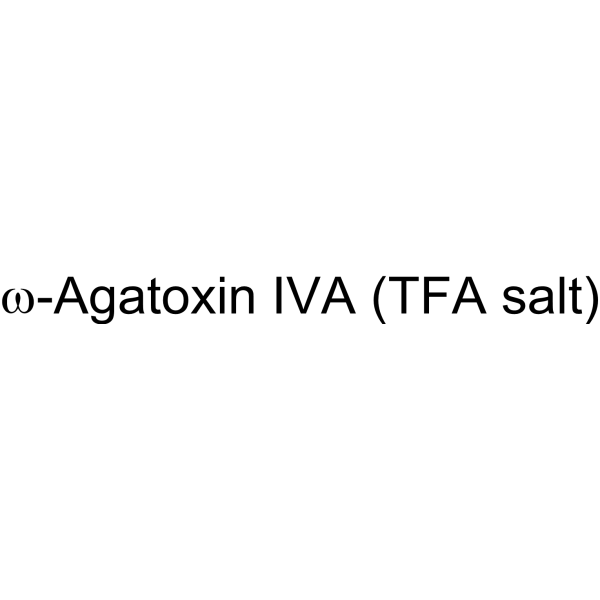
-
- HY-123205
-
|
|
Histamine Receptor
P2X Receptor
5-HT Receptor
|
Inflammation/Immunology
|
|
Oxatomide is a potent and orally active dual H1-histamine receptor and P2X7 receptor antagonist with antihistamine and anti-allergic activity. Oxatomide almost completely blocks the ATP-induced current in human P2X7 receptors (IC50 of 0.95 μM). Oxatomide inhibits ATP-induced Ca 2+ influx with an IC50 value of 0.43 μM and also inhibits serotonin .
|
-
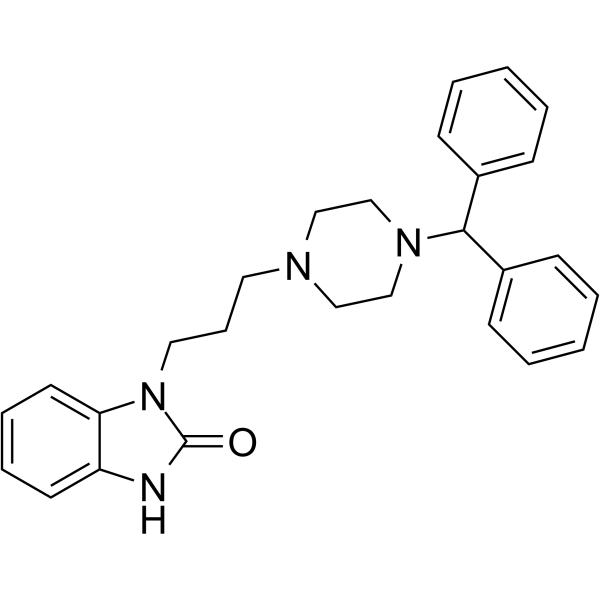
-
- HY-P1077
-
|
|
mGluR
Phosphodiesterase (PDE)
Apoptosis
Calmodulin
|
Inflammation/Immunology
|
|
CALP1 is a calmodulin (CaM) agonist (Kd of 88 µM) with binding to the CaM EF-hand/Ca 2+-binding site. CALP1 blocks calcium influx and apoptosis (IC50 of 44.78 µM) through inhibition of calcium channel opening. CALP1 blocks glutamate receptor channels and blocks a store-operated nonselective cation channel. CALP1 activates CaM-dependent phosphodiesterase activity .
|
-
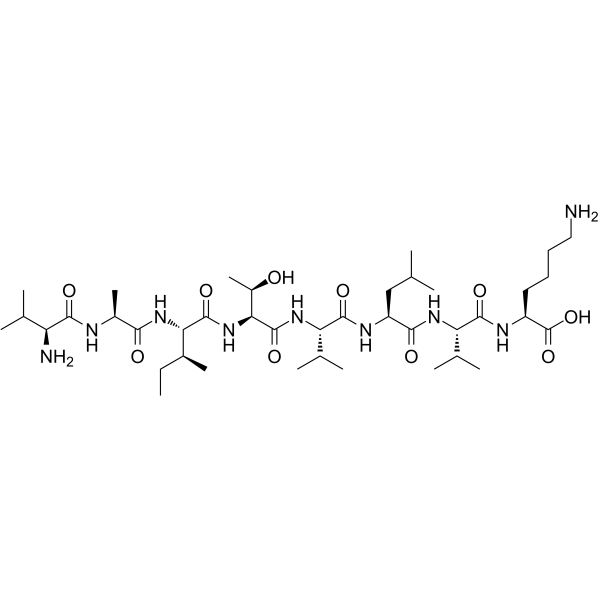
-
- HY-P1077A
-
|
|
mGluR
Phosphodiesterase (PDE)
Apoptosis
Calmodulin
|
Inflammation/Immunology
|
|
CALP1 TFA is a calmodulin (CaM) agonist (Kd of 88 µM) with binding to the CaM EF-hand/Ca 2+-binding site. CALP1 TFA blocks calcium influx and apoptosis (IC50 of 44.78 µM) through inhibition of calcium channel opening. CALP1 TFA blocks glutamate receptor channels and blocks a store-operated nonselective cation channel. CALP1 TFA activates CaM-dependent phosphodiesterase activity .
|
-
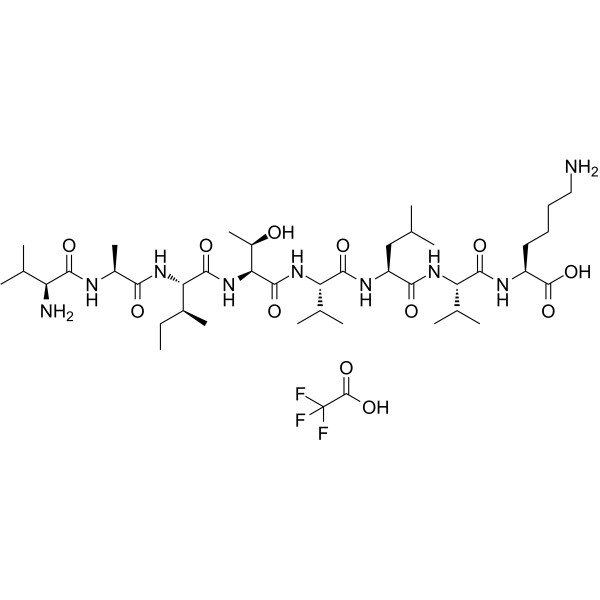
-
- HY-157131
-
|
|
TRP Channel
|
Neurological Disease
|
|
TRPV2-selective blocker 1 (compound IV2-1) is a selective TRPV2 channel blocker with an IC50 of 6.3 μM. TRPV2-selective blocker 1 does not affect TRPV1, TRPV3 or TRPV4 channels. TRPV2-selective blocker 1 also inhibits TRPV2-mediated Ca 2+ influx in macrophages, and inhibits macrophage phagocytosis .
|
-
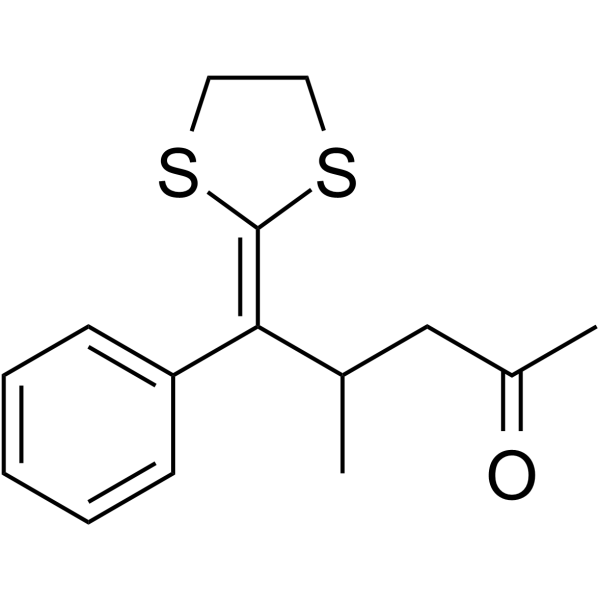
-
- HY-151547
-
|
|
P2X Receptor
|
Neurological Disease
|
|
MRS4719 is a potent P2X4 receptor antagonist with an IC50 value of 0.503 μM for human P2X4 receptor. MRS4719 can reduce infarct volume and reduce brain atrophy, showing neuroprotective and neuro-rehabilitative activities in ischemic stroke model. MRS4719 also reduces ATP-induced [Ca 2+]i influx in primary human monocyte-derived macrophages. MRS4719 can be used to research ischemic stroke .
|
-
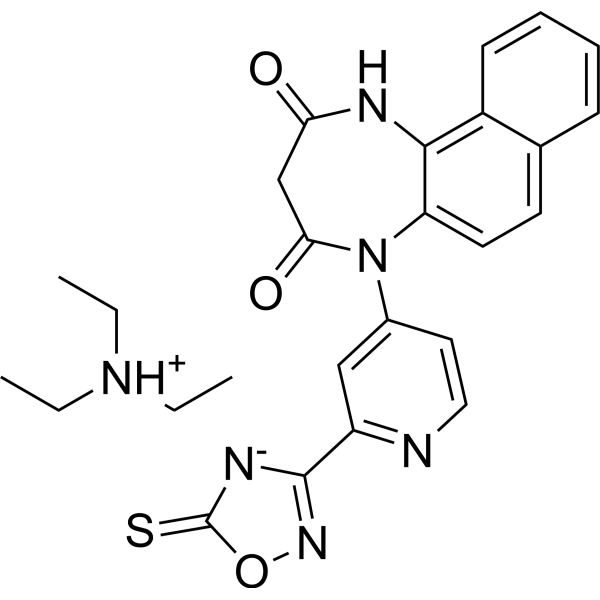
- HY-P1387
-
|
|
Amyloid-β
Apoptosis
|
Neurological Disease
|
|
β-Amyloid (1-40) (rat) is a rat form of the amyloid β-peptide, which accumulates as an insoluble extracellular deposit around neurons, giving rise to the senile plaques associated with Alzheimer's disease (AD). β-Amyloid (1-40) (rat) increases 45Ca 2+ influx, induces neurodegeneration in the rat hippocampal neurons of the CA1 subfield. β-Amyloid (1-40) (rat) induces apoptosis. β-Amyloid (1-40) (rat) can be used for the research of Alzheimer's disease .
|
-

- HY-N0043
-
-
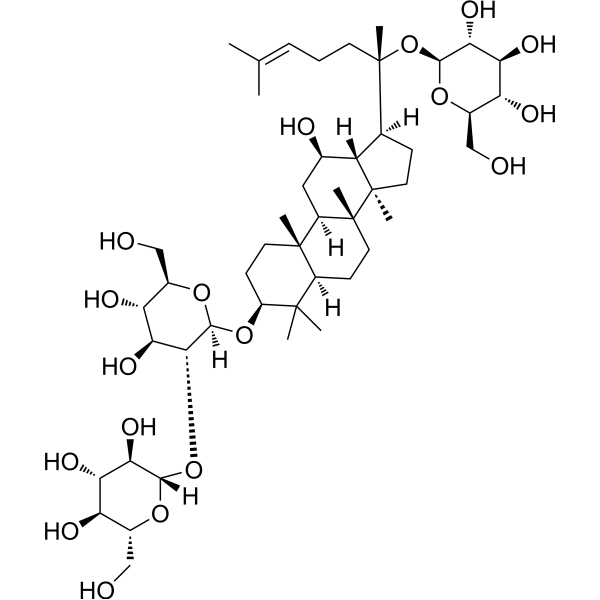
- HY-N0043R
-
|
Gypenoside VIII (Standard)
|
NF-κB
COX
Calcium Channel
Cytochrome P450
Endogenous Metabolite
|
Cardiovascular Disease
Inflammation/Immunology
Cancer
|
|
Ginsenoside Rd (Standard) is the analytical standard of Ginsenoside Rd. This product is intended for research and analytical applications. Ginsenoside Rd inhibits TNFα-induced NF-κB transcriptional activity with an IC50 of 12.05±0.82 μM in HepG2 cells. Ginsenoside Rd inhibits expression of COX-2 and iNOS mRNA. Ginsenoside Rd also inhibits Ca 2+ influx. Ginsenoside Rd inhibits CYP2D6, CYP1A2, CYP3A4, and CYP2C9, with IC50s of 58.0±4.5 μM, 78.4±5.3 μM, 81.7±2.6 μM, and 85.1±9.1 μM, respectively.
|
-

| Cat. No. |
Product Name |
Type |
-
- HY-100168
-
|
|
Biochemical Assay Reagents
|
|
BAPTA is a selective chelator for calcium. BAPTA, as calcium indicator, has high selectivity against magnesium and calcium. BAPTA is widely used as an intracellular buffer for investigating the effects of Ca 2+ release from intracellular stores or influx via Ca 2+-permeable channels in the plasma membrane. BAPTA can also inhibit phospholipase C activity independently of their role as Ca 2+ chelators .
|
-
- HY-100168B
-
|
|
Biochemical Assay Reagents
|
|
BAPTA tetrapotassium is a selective chelator for calcium. BAPTA, as calcium indicator, has high selectivity against magnesium and calcium. BAPTA tetrapotassium is widely used as an intracellular buffer for investigating the effects of Ca 2+ release from intracellular stores or influx via Ca 2+-permeable channels in the plasma membrane. BAPTA tetrapotassium can also inhibit phospholipase C activity independently of their role as Ca 2+ chelators .
|
| Cat. No. |
Product Name |
Target |
Research Area |
-
- HY-P1080A
-
|
|
Calcium Channel
|
Neurological Disease
|
|
ω-Agatoxin IVA TFA is a potent, selective P/Q type Ca 2+ (Cav2.1) channel blocker with IC50s of 2 nM and 90 nM for P-type and Q-type Ca 2+ channels, respectively. ω-Agatoxin IVA TFA (IC50, 30-225 nM) inhibits glutamate exocytosis and calcium influx elicited by high potassium. ω-Agatoxin IVA TFA also blocks the high potassium-induced release of serotonin and norepinephrine. ω-Agatoxin IVA TFA has no effect on L-type or N-type calcium channels .
|
-
- HY-P3037
-
|
|
Calcium Channel
|
|
|
Imperatoxin A, a peptide toxin derived from the venom of the African scorpion Pandinus imperator, activator of Ca 2+-release channels/ryanodine receptors (RyRs)? enhances the influx of Ca 2+ from the sarcoplasmatic reticulum into the cell .
|
-
- HY-P5796
-
|
|
Calcium Channel
|
Neurological Disease
|
|
FS-2 is a potent and specific L-type CaV channel inhibitor. FS-2 inhibits high K + or glucose induced L-type Ca 2+ influx in RIN beta cells .
|
-
- HY-P3156
-
|
|
Fungal
|
Infection
|
|
Syringomycin E is an antifungal cyclic lipodepsinonapeptide. Syringomycin E exhibits growth inhibition of Saccharomyces cerevisiae through interaction with the plasma membrane. Syringomycin E causes K + efflux, Ca 2+ influx, and changes in membrane potential, and is related to channel formation .
|
-
- HY-P1080
-
|
|
Calcium Channel
|
Neurological Disease
|
|
ω-Agatoxin IVA is a potent, selective P/Q type Ca 2+ (Cav2.1) channel blocker with IC50s of 2 nM and 90 nM for P-type and Q-type Ca 2+ channels, respectively. ω-Agatoxin IVA (IC50, 30-225 nM) inhibits glutamate exocytosis and calcium influx elicited by high potassium. ω-Agatoxin IVA also blocks the high potassium-induced release of serotonin and norepinephrine. ω-Agatoxin IVA has no effect on L-type or N-type calcium channels .
|
-
- HY-P1077
-
|
|
mGluR
Phosphodiesterase (PDE)
Apoptosis
Calmodulin
|
Inflammation/Immunology
|
|
CALP1 is a calmodulin (CaM) agonist (Kd of 88 µM) with binding to the CaM EF-hand/Ca 2+-binding site. CALP1 blocks calcium influx and apoptosis (IC50 of 44.78 µM) through inhibition of calcium channel opening. CALP1 blocks glutamate receptor channels and blocks a store-operated nonselective cation channel. CALP1 activates CaM-dependent phosphodiesterase activity .
|
-
- HY-P1077A
-
|
|
mGluR
Phosphodiesterase (PDE)
Apoptosis
Calmodulin
|
Inflammation/Immunology
|
|
CALP1 TFA is a calmodulin (CaM) agonist (Kd of 88 µM) with binding to the CaM EF-hand/Ca 2+-binding site. CALP1 TFA blocks calcium influx and apoptosis (IC50 of 44.78 µM) through inhibition of calcium channel opening. CALP1 TFA blocks glutamate receptor channels and blocks a store-operated nonselective cation channel. CALP1 TFA activates CaM-dependent phosphodiesterase activity .
|
-
- HY-P1387
-
|
|
Amyloid-β
Apoptosis
|
Neurological Disease
|
|
β-Amyloid (1-40) (rat) is a rat form of the amyloid β-peptide, which accumulates as an insoluble extracellular deposit around neurons, giving rise to the senile plaques associated with Alzheimer's disease (AD). β-Amyloid (1-40) (rat) increases 45Ca 2+ influx, induces neurodegeneration in the rat hippocampal neurons of the CA1 subfield. β-Amyloid (1-40) (rat) induces apoptosis. β-Amyloid (1-40) (rat) can be used for the research of Alzheimer's disease .
|
| Cat. No. |
Product Name |
Category |
Target |
Chemical Structure |
| Cat. No. |
Product Name |
Chemical Structure |
-
- HY-14656S
-
|
|
|
Diltiazem-d3 (hydrochloride) is the deuterium labeled Diltiazem hydrochloride. Diltiazem hydrochloride is a Ca2+ influx inhibitor (slow channel blocker or calcium antagonist)[1][2].
|
-

-
- HY-14656S1
-
|
|
|
Diltiazem-(acetoxy-d3) (hydrochloride) is the deuterium labeled Diltiazem hydrochloride. Diltiazem hydrochloride is a Ca2+ influx inhibitor (slow channel blocker or calcium antagonist)[1][2].
|
-

Your information is safe with us. * Required Fields.
Inquiry Information
- Product Name:
- Cat. No.:
- Quantity:
- MCE Japan Authorized Agent:





























































